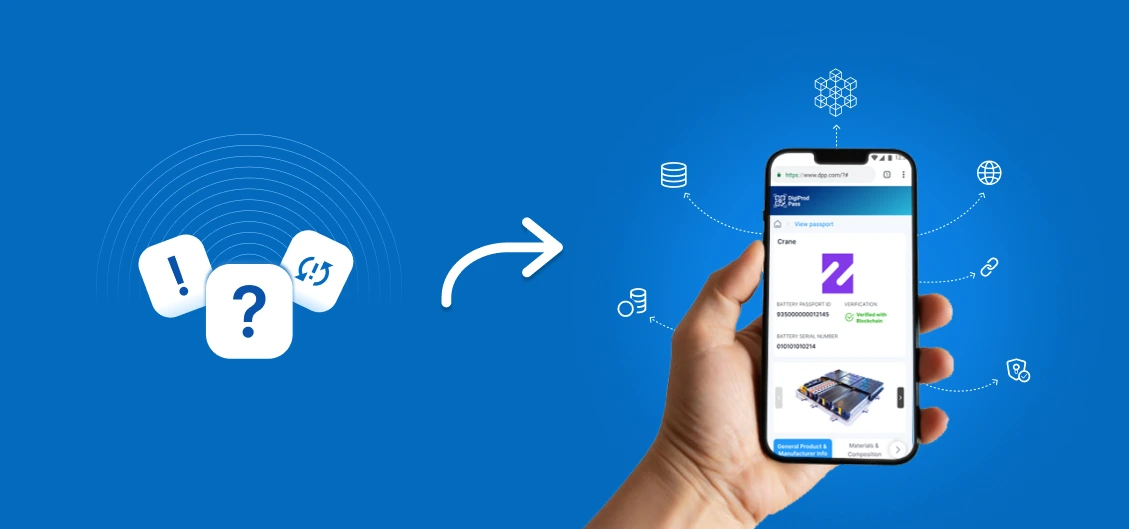
The European Commission is strongly advocating for the ESPR initiative. This means that products in industries that have a big environmental impact will need Digital Product Passports (DPPs). The goal is to make all product information consistent, easy to scan with QR codes, and smoothly integrated into digital systems, especially with the European Digital Product Passport framework.
But is DPP easy to incorporate fruitfully right away? The answer is “NO”; it has some difficulties, such as high implementation costs, technological gaps, and the absence of common standards. Concerns like data privacy and global supply chain complexities are other significant hurdles. And we can see clearly why widespread adoption of DPP is still in the ‘work-in-progress’ phase.
Digital Product Passport is a solution to foster a circular economy and a sustainable world. Although this technology has some limitations, there are also backups.
Barriers: Getting detailed data from every corner of the supply chain is still a huge headache. A lot of suppliers, mostly in developing regions, just don’t have the digital systems needed to track or share this information properly. Most brands can keep tabs on their core suppliers, but once they pass the first layer, it gets complex. The data becomes irregular, hard to trust, and it slows everything down when it comes to meeting new rules or getting systems in place. That’s important because the ESPR rules require a high level of traceability—from start to finish. Companies need to show where materials come from, how recyclable a product is, and even how much carbon was involved in making it.
Solution: Blockchain Technology is an emerging solution to this problem. This decentralised digital ledger helps keep all records with maximum transparency. All records of transactions are stored within blocks and are connected using cryptography.
Barrier: Every industry and region has unique tools and processes; their tools, platforms, and Identity systems are different. Without a shared standard for the Digital Product Passport, maintaining and connecting everything is being compromised. Mismatched data, policy rollouts, and regional regulation barriers make everything tough to operate.
Solution: The challenge has also become easier with DigiProd Pass Ltd., which offers a platform for organisations to simplify the process. The manufacturer can stay connected with the suppliers with automated data collection. Moreover, this platform ensures that everything is aligned with the EU rules.
Barrier: Data privacy is an important aspect of digital product passports. The manufacturer must display the product details thoroughly; then again, they are bound to maintain the privacy of the data subject. Disclosing some data about a product or a making process could be sensitive. So, it is a delicate challenge for the manufacturer to cope with. They require a sorted cloud or hub where this data processing comes under a common norm, while data is protected with thoughtfully designed tools to smooth data sharing.
Solution: Luckily, technologies like blockchain are built to mitigate these challenges through permission-based data sharing, encryption and distributed storage.
Barriers: Setting up a Digital Product Passport (DPP) system is expensive. From buying the right software, incorporating QR CODE, RFID tags, connecting everything to existing systems, and training staff, it all adds up. These upfront costs are a lot for small businesses. And since the payoff isn’t always immediate, it’s easy to see why many are hesitant. A survey by Flash Eurobarometer 486 found that nearly 62% of SMEs don’t feel ready for DPP requirements because of tight budgets.
Solutions: It is a fact that DPP is a financial burden for the small businesses but it is also true that denying the needs of DPP will cost them even more financially. As DPP is playing e vital role in converting the linear economy to circularity, and the regulations demand it, the businesses can not avoid this requirement; otherwise, they have to pay the penalties, so the solution is to adopt DPP considering it as an advancement, not a burden.
Barriers: The ESPR will be implemented via delegated acts between 2025 and 2030. With technical specifications still evolving, companies lack a fixed blueprint, creating hesitation in early investment. Textile and battery fields will likely have to face the first wave obligations in the upcoming years of 2026–2027. So, things are uncertain until a settled situation in ESPR compliance is reached.
Solutions: The implementations of DPP will be coming phase by phase, from big to small. So the companies will get enough time to be prepared to adopt DPP. The fact is, the regulation is a new normal, unavoidable. Hence, getting ready to adopt it will increase the chance of competitiveness in the market.
Implementing a Digital Product Passport comes with hurdles and challenges, undoubtedly. The dangers of delaying action, such as regulatory penalties, a lack of supply chain transparency, and weakened consumer trust, are considerably severe. However, businesses that take initiative, make cross-sector collaboration, and invest in scalable infrastructure will be hitting the next wave of sustainable innovation.
Sources



.svg)
.svg)